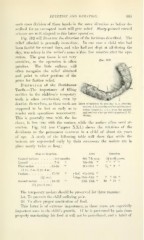Page 667 - My FlipBook
P. 667
: " :
ERUPTION AND DURATION. '665
such cases division of these bands in the same direction as before de-
scribed for an unerupted tooth will give relief. Sharp-pointed curved
scissors are well adapted to this latter operation.
Fig. 592 Avill illustrate the direction of the incisions described. The
relief aiforded is generally immediate. In one case a child who had
been fretful for several days, and who had not slept at all during the
day, was asleep in the writer's arms within five minutes after the ope-
ration. The gum tissue is not very
sensitive, so the operation is often ^^' "
^^^^
painless. The little sufferer will .^^\^a
often recognize the relief obtained /^
%l
and point to other portions of the 1"\/^
gums for further relief. ,ili^ / ,i
Duration of the Deciduous ^ti^ ' ^ * /-w*/ /
Teeth.—The importance of filling ^ - ^ ^^^^ ^ -'*>-', ^
cavities in the children's temporary "^i^
"^^^S^^
teeth is often overlooked, even by -=^^ \
dentists themselves, as these teeth are Lines of incision in lanclng : a, a, over the
, J I I , , molars ; 6, 6, over the canines and incisors
supposed to be lost so early as to before eruption : c, c, c, over the molars
render such operations Unnecessarv. an«5 canines after partial eruption (J. w.
-' White).
r^, . . 11 • 1 1
This is generally true with the in-
cisors, is less true with the canines, while the molars often need at-
tention. Fig. 541 (see Chapter XXI.) shows the relations of the
deciduous to the permanent dentures in a child of about six years
of age. A study of the following table will show that while the
incisors are superseded early by their successors the molars are in
place nearly twice as long
Time of Eruption. Loss. Duration.
Central incisors 6-8 months. 6th-7th year. 5i to 6J years.
u \c
Lateral 7-9 " 7th-8th « « ,;
First molars 14-16 " 9th-10th " 7^" 9 "
(1 yr. 2 m.-l yr. 4 m.)
"
Canines 17-18 " flnf. 8th-10th
(liyrs.) tSup.lltli-12th " 7 " 10 "
Second molars 18-24 " 12th-13th " 10 " 11 "
(\\ yrs.-2yrs.)
The temporary molars should be preserved for three reasons
1st. To prevent the child suffering pain.
2d. To allow proper mastication of food.
This latter is of extreme importance, as these years are especially
important ones in the child's growth. If he is prevented by pain from
properly masticating his food it will not be assimilated, and a habit of
ERUPTION AND DURATION. '665
such cases division of these bands in the same direction as before de-
scribed for an unerupted tooth will give relief. Sharp-pointed curved
scissors are well adapted to this latter operation.
Fig. 592 Avill illustrate the direction of the incisions described. The
relief aiforded is generally immediate. In one case a child who had
been fretful for several days, and who had not slept at all during the
day, was asleep in the writer's arms within five minutes after the ope-
ration. The gum tissue is not very
sensitive, so the operation is often ^^' "
^^^^
painless. The little sufferer will .^^\^a
often recognize the relief obtained /^
%l
and point to other portions of the 1"\/^
gums for further relief. ,ili^ / ,i
Duration of the Deciduous ^ti^ ' ^ * /-w*/ /
Teeth.—The importance of filling ^ - ^ ^^^^ ^ -'*>-', ^
cavities in the children's temporary "^i^
"^^^S^^
teeth is often overlooked, even by -=^^ \
dentists themselves, as these teeth are Lines of incision in lanclng : a, a, over the
, J I I , , molars ; 6, 6, over the canines and incisors
supposed to be lost so early as to before eruption : c, c, c, over the molars
render such operations Unnecessarv. an«5 canines after partial eruption (J. w.
-' White).
r^, . . 11 • 1 1
This is generally true with the in-
cisors, is less true with the canines, while the molars often need at-
tention. Fig. 541 (see Chapter XXI.) shows the relations of the
deciduous to the permanent dentures in a child of about six years
of age. A study of the following table will show that while the
incisors are superseded early by their successors the molars are in
place nearly twice as long
Time of Eruption. Loss. Duration.
Central incisors 6-8 months. 6th-7th year. 5i to 6J years.
u \c
Lateral 7-9 " 7th-8th « « ,;
First molars 14-16 " 9th-10th " 7^" 9 "
(1 yr. 2 m.-l yr. 4 m.)
"
Canines 17-18 " flnf. 8th-10th
(liyrs.) tSup.lltli-12th " 7 " 10 "
Second molars 18-24 " 12th-13th " 10 " 11 "
(\\ yrs.-2yrs.)
The temporary molars should be preserved for three reasons
1st. To prevent the child suffering pain.
2d. To allow proper mastication of food.
This latter is of extreme importance, as these years are especially
important ones in the child's growth. If he is prevented by pain from
properly masticating his food it will not be assimilated, and a habit of


